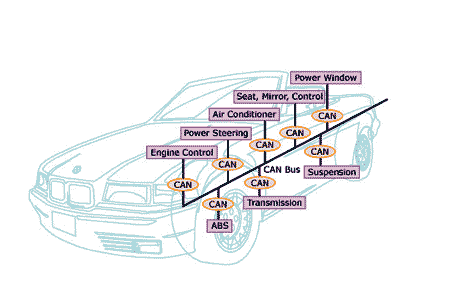| 2003 |

|
YEAR BOOK |
Limerick Institute of Technology
|
Intelligent automotive networks for distributed real-time control
|

The diagram shows a typical CAN network in a car. Typical applications include Anti-lock Braking System (ABS), airbags, intelligent motor management, navigation systems such as Global Positioning System (GPS), future entertainment systems including DVD and games consoles, door locking and window control. It would be virtually impossible to connect all these components together without a computer network such as the CAN. In general, CAN is suitable for applications where several microcontroller based devices have to communicate with each other.
The CAN protocol is also gaining widespread popularity in other areas such as industrial automation, railways, trucks, medical equipment, test equipment and mobile machines.
One of the main aims of this research is to analyse CAN from a number of perspectives in distributed real-time control systems. This analysis is based on industrial case studies in automation and a number of identified real-time irregularities in the protocol. These include computer-based time variations that can deteriorate performance for control applications, scheduling problems, over emphasis on bitrate performance, lack of a global clock etc. This research will attempt to decentralise the communications through the use of powerful processors at each CAN node and thus achieve stable real-time distributed control.
Further aims include: the design and development of appropriate distributed devices to construct a simulation of an industrial case study; the dissemination of the appropriate network architecture, and case studies to demonstrate the efficiencies and benefits of this approach.
It is hoped that this research will lead to the development of a novel distributed operating system or application for managing the network communications.
Contact: John Cosgrove & Brendan Donnelly, Department of Electrical/Electronic Engineering, LIT; E-mail: [email protected] & [email protected]